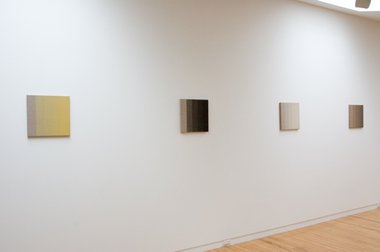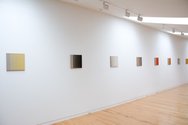John Hurrell – 29 August, 2010
With the different degrees of colour saturation, and the amount of pigment suspended in the water and acrylic medium during application, the tiny particles of brushed on paint tend to gather along the outer vertical edge, and are thinner towards the centre. Despite this interesting, incredibly nuanced, factor, these paintings end up being too bland, for they look like student exercises in tone or saturation, lacking visual dynamic and emotional impact.
Eight ‘daily paintings’ from Simon Morris are stretched out in a long line on the main wall in the narrow upstairs gallery at Two Rooms. Each one is on brown linen placed over a 360 x 360 mm stretcher, that woven square divided into five equally wide vertical strips, each line allocated for a working day, each canvas symbolising a working week.
The logic of the works is this, that every day Morris paints one further layer of thin acrylic onto the surface of each stretcher, but leaves a vertical strip untouched (on the left) of the previous day’s layer. With the Two Rooms selection, made from a larger pool of works, a tooth-providing and sealing coat of transparent size on the linen is left exposed so that the subsequent acrylic layers (four of them) can gradually build on that.
With the different degrees of colour saturation, and the amount of pigment suspended in the water and acrylic medium during application, the tiny particles of brushed on paint tend to gather along the outer vertical edge, and are thinner towards the centre. Despite this interesting, incredibly nuanced, factor, my view is that these paintings end up too bland, for individually they look like student exercises in tone or saturation, lacking visual dynamic and emotional impact. The value of this show lies not in the individual works but in the arrangement of the group, especially when seen in the natural light coming in through the skylight and bouncing off the white walls.
Morris’ positioning of his eight paintings overall showcases their qualities of chromatic temperature, cool near the office end of the space, hotter near the blind wall end. Black, lemon yellow and very pale grey one extreme; red, brown and rusty orange the other.
These temperature changes are not within one smoothly transitional gradient however. They sufficiently vary and clash to make a kind of repeating pulse, one that is moved along by the tonal contrast caused by the lefthand strip of each canvas being unpainted - a vertical accentuation.
We thus end up with an elegant grouping where the resulting experience is a lot more than the sum of the parts, the result not of isolated but of co-ordinated elements. A lovely driving orchestration of muted chords along the Two Rooms wall.
John Hurrell
Recent Comments
John Hurrell
Yes well these works don't have the coding to do specifically with time that he put in the titles or ...
Kim Finnarty
John you managed that review without mentioning On Kawara. I wonder if these paintings were painted sequentially over 32 days ...




 Two Rooms presents a program of residencies and projects
Two Rooms presents a program of residencies and projects Advertising in this column
Advertising in this column



This Discussion has 2 comments.
Comment
Kim Finnarty, 10:04 a.m. 31 August, 2010 #
John you managed that review without mentioning On Kawara.
I wonder if these paintings were painted sequentially over 32 days and if indeed the unpainted strip equates to a day in itself; Sundays perhaps.
Was there any editing, are these the 'best of' days? or was this a strictly bounded project?
and that weird colour /temperature shift, is that a seasonal shift, a mood change in the artist or a painterly conceit?
John Hurrell, 11:32 a.m. 31 August, 2010 #
Yes well these works don't have the coding to do specifically with time that he put in the titles or linear pictographic orientation of other series. My impression is that these are more about the pleasure of handling the medium as part of a daily routine, but something tangential to other more crucial projects on the boil.
Karawa is so specific and 'Daily' is comparatively vague. The numbers of the painting titles don't indicate a conceptual tightness or any sequential ordering. I think Simon improvised when in the space. Thank God for that.
Participate
Register to Participate.
Sign in
Sign in to an existing account.